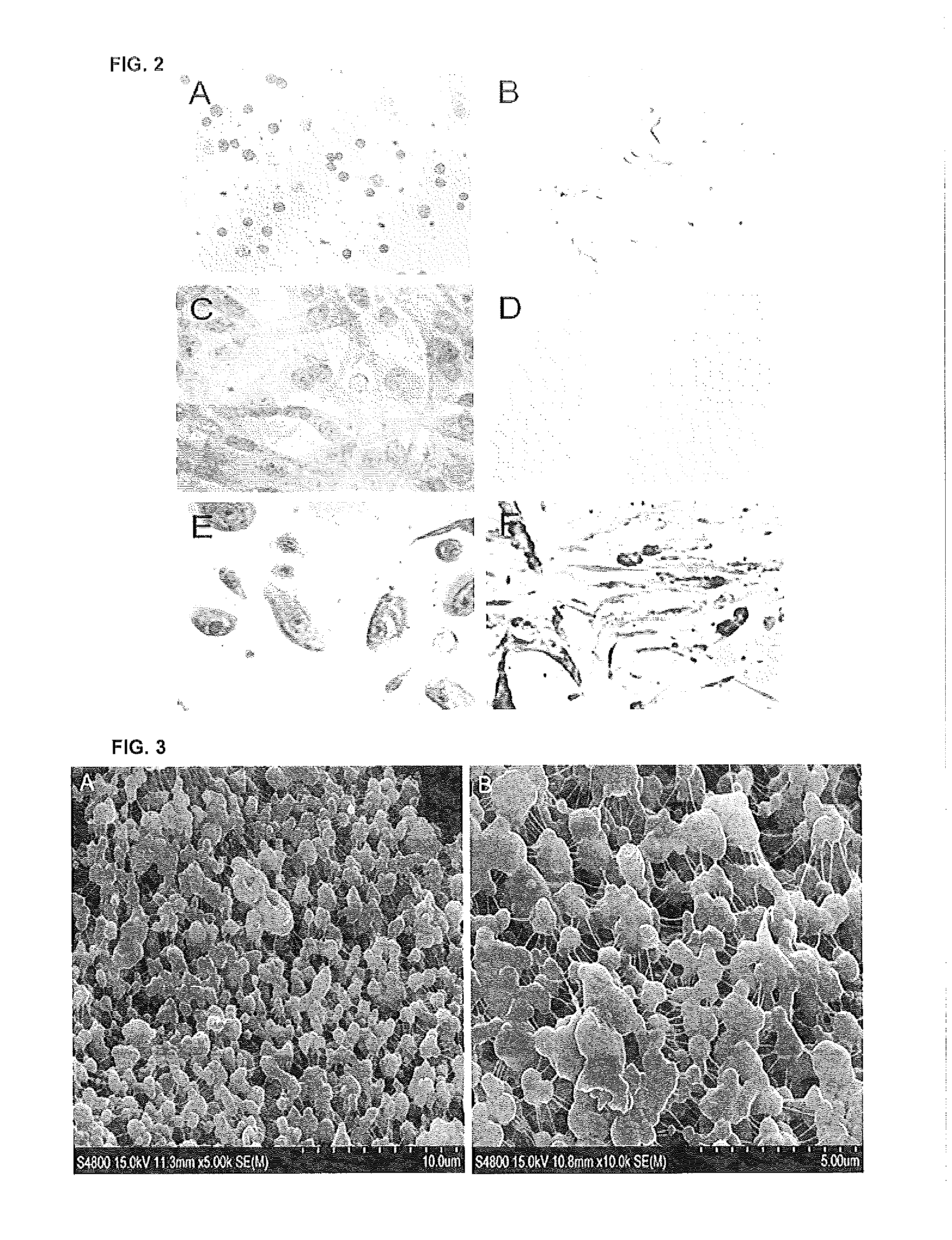Biomaterial from wharton's jelly umbilical cord
a technology of umbilical cord and biomaterial, which is applied in the field of biomaterials, can solve the problems of induration (hardening of organ tissues), necrosis of mucosae, and inability to achieve the exact composition that simulates the natural conditions of a specific tissu
- Summary
- Abstract
- Description
- Claims
- Application Information
AI Technical Summary
Benefits of technology
Problems solved by technology
Method used
Image
Examples
example 1
Obtaining Wharton's Jelly
[0106]The following example was performed with both human- and porcine-sourced umbilical cords. To isolate the GAGs from the WJ of the respective umbilical cords, the procedure below was followed.
[0107]In each case, a 50 g umbilical cord was collected immediately after delivery in a sterile bottle in which 300 ml of PBS at 1× concentration (for 1 liter of H2O: 8 g NaCl, 0.2 g KCl, 1.44 g Na2HPO4, 0.24 g KH2PO4, pH-7.4 in 1 L of H2O) and 3 ml of a mixture of antibiotics of penicillin (30,000 units), streptomycin (30,000 μg) and amphotericin-B (75 μg) (LONZA, Ref: 17-745E) at 1× concentration, had previously been deposited. The umbilical cords can be stored at 4° C. for not more than 24 hours until processing, but in this example the umbilical cords were processed immediately after they were received.
[0108]For processing, the umbilical cords were maintained in sterile conditions in a biosafety level II laminar flow hood and were subjected to successive washing...
example 2
Extraction of GAGs from Wharton's Jelly
[0111]The following example was performed with both human- and porcine-sourced umbilical cords. A protocol described to obtain GAGs from human cartilage was utilized, with some modifications, to obtain GAGS from the WJ of the umbilical cord (Rogers et al., 2006).
[0112]Both WJ obtained in Example 1 were immersed in 20 ml of the extraction buffer solution (242 μl of 200 mM L-cysteine, 1.42 ml of 704 mM Na2HPO4 buffer, 100 μl of 0.5 M EDTA, 10 mg (14 U / mg), pH 7.5) papain (SIGMA, Ref: P4762) and they were maintained at 60° C. for 12 hours to completely digest the WJ, and once they were digested, the samples were centrifuged at 1,500 g for 5 minutes to remove the digestion residue. It was observed that the digestion volumes were approximately 30 ml, approximately 10 ml more than the starting volume of 20 ml, due to the dissolution of the GAGs present in the WJ and therefore due to the release of the water that these had accumulated.
[0113]Once the s...
example 3
Precipitation and Isolation of GAGs from the WJ of the Umbilical Cord
[0114]The GAGs of the WJ present in the supernatant of example 2 were precipitated out with 5 volumes of 100% ethanol. By means of this step, the GAGs of the samples as well as salts present therein were precipitated out. This is due to the fact that the water molecules present in the samples interact with the ethanol molecules, such that the water molecules cannot interact with the GAGs of the samples. The GAGs were left to precipitate for 12 hours at −20° C. Once precipitated out, they were centrifuged at 1,500 g for 5 minutes, all the 100% ethanol thus being removed. The precipitate was washed with 5 volumes of 75% ethanol to remove the possible residual salts that may have precipitated out in the sample. Then it was centrifuged about 5 minutes at 1,500 g and the supernatant was completely removed.
[0115]Once the samples have precipitated, the solid residue was left to dry for about 30 minutes at ambient temperat...
PUM
| Property | Measurement | Unit |
|---|---|---|
| Length | aaaaa | aaaaa |
| Fraction | aaaaa | aaaaa |
| Fraction | aaaaa | aaaaa |
Abstract
Description
Claims
Application Information
 Login to View More
Login to View More - R&D
- Intellectual Property
- Life Sciences
- Materials
- Tech Scout
- Unparalleled Data Quality
- Higher Quality Content
- 60% Fewer Hallucinations
Browse by: Latest US Patents, China's latest patents, Technical Efficacy Thesaurus, Application Domain, Technology Topic, Popular Technical Reports.
© 2025 PatSnap. All rights reserved.Legal|Privacy policy|Modern Slavery Act Transparency Statement|Sitemap|About US| Contact US: help@patsnap.com



